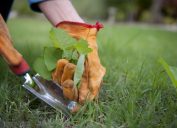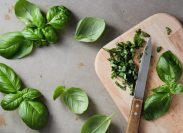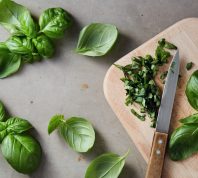The 6 Best Herbs to Plant for Beginners, Experts Say
Some herbs are easier to keep alive than others, according to gardening gurus.
Compared to big, beautiful houseplants or flowering outdoor garden beds, herbs can feel like child's play. But the truth is that growing herbs takes just as much finesse, and they're not all created equal. If you're thinking of starting your own herb garden—whether inside on your windowsill or in the backyard—we've spoken to plant and garden experts about which herbs are the best for beginners. Read on to learn what makes them easy to care for, and how you can best keep them flourishing.
READ THIS NEXT: 5 House Plants That Don't Need Sunlight.
1
Basil

You don't have to love pizza and pasta to grow basil—though it certainly doesn't hurt! The Italian staple is considered one of the most low-maintenance herbs. "Basil's easy to care for and grow because it tolerates summer heat, it produces a ton of leaves, and it'll keep producing as long as you keep it pruned," says John Thomas, founder of Backyard Garden Geek.
Basil does well in a pot or the ground, but either way, it likes moist soil and requires about one inch of water per week, according to Daniel Powers, founder of The Botanical Institute. Of course, if you've planted outside, super-hot weeks may warrant a little extra water. "If you plan on growing basil in a pot, make sure that it gets plenty of sun," Powers says.
Basil does tend to get a bit unwieldy. Without pruning, your plant may "only have a single stem that'll grow tall and wobbly as the season progresses." To counter this, he advises gardeners to look at the main stem and find pairs of leaves growing from it. Then, "select an area that's above at least two to three pairs of leaves, and snip the main stem … The basil plant will produce new stems out of each of the joints below the cut you've made."
2
Mint
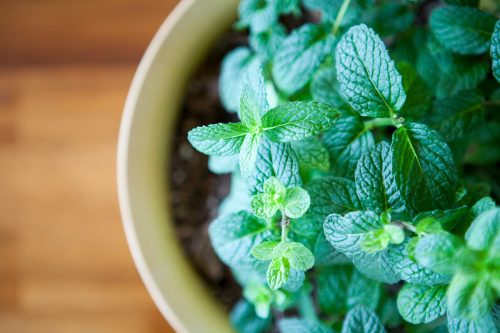
Mint is a fun herb to grow because it's used in food as well as drinks (mojito, anyone?). There are also several varieties—spearmint, peppermint, lemon balm, to name a few—that require similar care, according to Jane Windham, founder of the website Cottage at the Crossroads. It's a perennial, so it'll return year after year, and "it will be one of the first things to pop up each spring and will last well into the fall, as it's semi-cold hardy," she says.
Most importantly, it's also beginner-friendly. "Mint is an extremely hardy herb that is difficult to kill. Forgetting to water your mint is no problem—it will simply go dormant, patiently waiting for you to remember to water it again," says Chris Chan of Garden Bench Top.
For mint to thrive, Andrew Porwol, owner of Garden Centre Shopping in the U.K., says to "place it in a sunny or even partially shaded area and keep the soil moist." Like basil, mint that's happy can start to grow out of control. It is, after all, an invasive plant. To counter this, Porwol recommends containing it in its own large pot and cutting it back often. However, "never cut more than a third of the leaves in one shot," he cautions.
READ THIS NEXT: 5 Easy Hacks to Save Your House Plants That Gardeners Swear By.
3
Chives
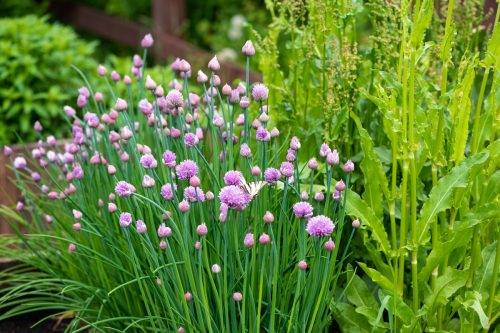
A little bit garlic, a little bit onion, chives are one of the most versatile herbs out there. Also a perennial, they "grow well in full sun or partial shade and require very little maintenance other than regular watering," says Kelly Martin, founder of the website Urban Garden Gal.
Another benefit to chives is that they can add some color to your herb garden. "They produce beautiful purple flowers in summer," Martin notes. (Bonus—these flowers are edible!) Come fall, when they're done flowering, "the plants can be cut back to ground level," she adds. According to Porwol, chives can also "live through harsh winters as long as covered."
4
Rosemary

A robust herb, rosemary calls to mind roasted chicken and potatoes. But it's equally hardy in the growing department. "It's a shrubby evergreen herb that has an upright growth habit … and tops out at two feet tall," explains Jen Stark, founder of the blog Happy DIY Home. Rosemary does well indoors or outdoors, but it prefers full sun.
What really makes this herb great for beginners is its affinity for drier soil, so it can withstand a missed watering here and there. This does mean that it's more susceptible to root rot, Stark notes, so if you're using a pot, it's best to choose one with a drainage hole and saucer.
5
Thyme

Thyme is a lovely herb when you're looking for a subtle flavor. Like rosemary, this perennial herb "can tolerate some neglect," says Rodger St. Hilaire, founder of the website Gardening Boost. "As far as watering goes, thyme is pretty drought-tolerant, so you don't need to worry about over-watering. Just make sure the soil is dry before watering again," he explains.
Thyme does tend to get pretty bushy, Hilaire cautions, so plant it in a large enough pot or in a bed where it has room to spread out. If it starts getting too wild, he says to trim it back once in a while.
For more plant advice delivered straight to your inbox, sign up for our daily newsletter.
6
Dill
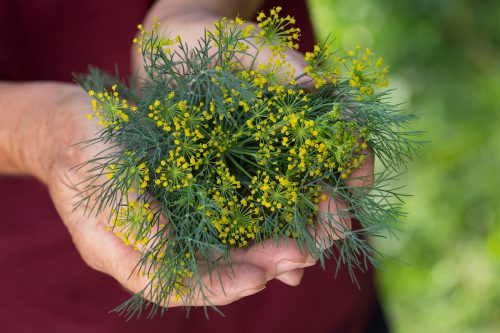
Dill might not be the herb you reach for most often, but its sweet and slightly tangy flavor is crucial to many soups, salads, and salmon dishes. If you're interested in having your own stock of this herb, you're in luck, as it's one of the quickest-growing herbs, notes Chan. "Keep the soil moist and in a position that receives six to eight hours of sunlight, and you'll be enjoying your freshly cut dill in just over a month," he says.
According to Angelia Daugirda, senior manager of creative operations at Organic Plant Magic, dill can get quite tall and have a hard time staying upright (it also makes it a victim of wind). To counter this, she suggests planting dill in clumps so it can naturally support itself. She also shares that the "large spread out flower heads are one of the prettiest edible additions to a garden."

